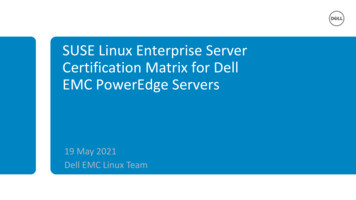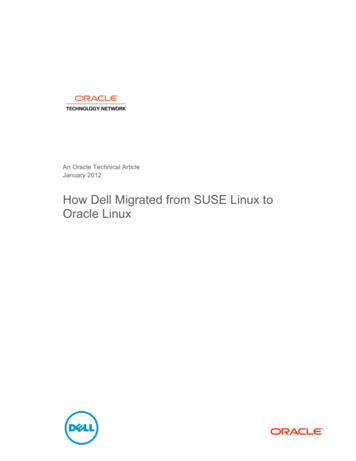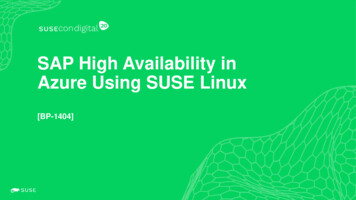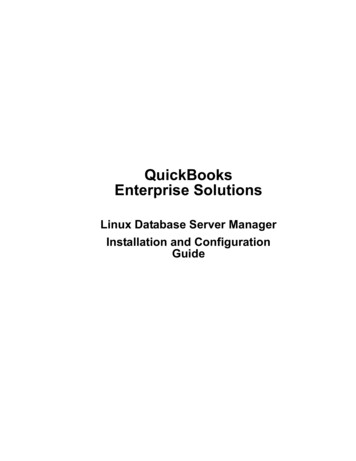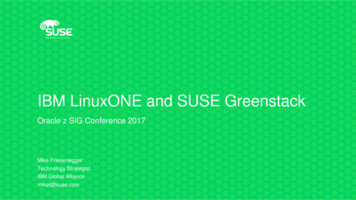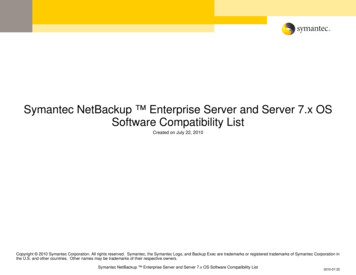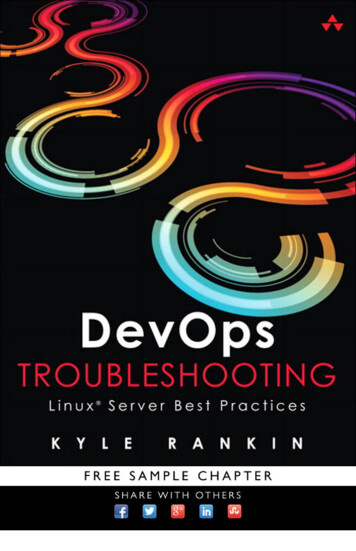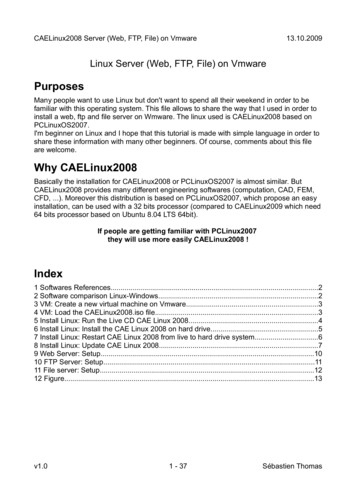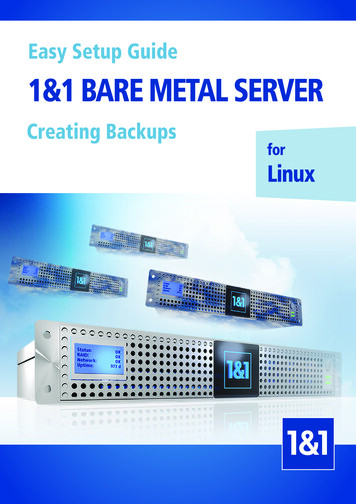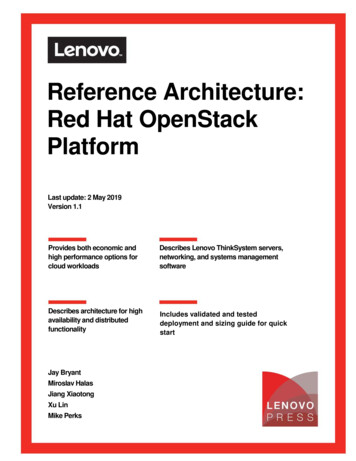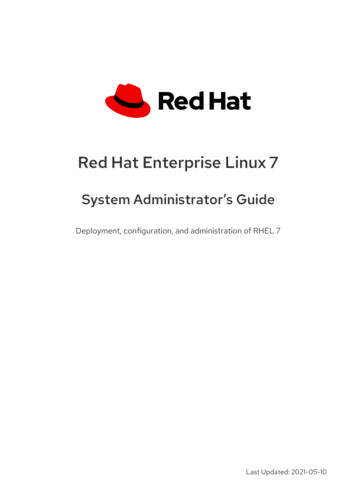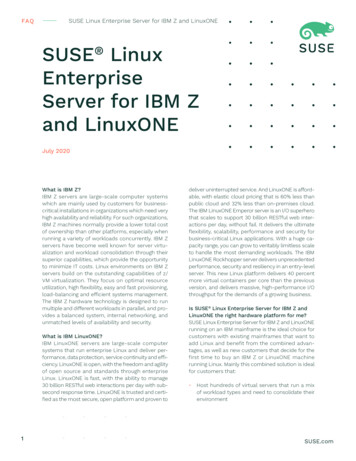
Transcription
FAQSUSE Linux Enterprise Server for IBM Z and LinuxONESUSE LinuxEnterpriseServer for IBM Zand LinuxONEJuly 2020What is IBM Z?IBM Z servers are large-scale computer systemswhich are mainly used by customers for businesscritical installations in organizations which need veryhigh availability and reliability. For such organizations,IBM Z machines normally provide a lower total costof ownership than other platforms, especially whenrunning a variety of workloads concurrently. IBM Zservers have become well known for server virtualization and workload consolidation through theirsuperior capabilities, which provide the opportunityto minimize IT costs. Linux environments on IBM Zservers build on the outstanding capabilities of z/VM virtualization. They focus on optimal resourceutilization, high flexibility, easy and fast provisioning,load-balancing and efficient systems management.The IBM Z hardware technology is designed to runmultiple and different workloads in parallel, and provides a balanced system, internal networking, andunmatched levels of availability and security.What is IBM LinuxONE?IBM LinuxONE servers are large-scale computersystems that run enterprise Linux and deliver performance, data protection, service continuity and efficiency. LinuxONE is open, with the freedom and agilityof open source and standards through enterpriseLinux. LinuxONE is fast, with the ability to manage30 billion RESTful web interactions per day with subsecond response time. LinuxONE is trusted and certified as the most secure, open platform and proven to1deliver uninterrupted service. And LinuxONE is affordable, with elastic cloud pricing that is 60% less thanpublic cloud and 32% less than on-premises cloud.The IBM LinuxONE Emperor server is an I/O superherothat scales to support 30 billion RESTful web interactions per day, without fail. It delivers the ultimateflexibility, scalability, performance and security forbusiness-critical Linux applications. With a huge capacity range, you can grow to veritably limitless scaleto handle the most demanding workloads. The IBMLinuxONE Rockhopper server delivers unprecedentedperformance, security and resiliency in an entry-levelserver. This new Linux platform delivers 40 percentmore virtual containers per core than the previousversion, and delivers massive, high-performance I/Othroughput for the demands of a growing business.Is SUSE Linux Enterprise Server for IBM Z andLinuxONE the right hardware platform for me?SUSE Linux Enterprise Server for IBM Z and LinuxONErunning on an IBM mainframe is the ideal choice forcustomers with existing mainframes that want toadd Linux and benefit from the combined advantages, as well as new customers that decide for thefirst time to buy an IBM Z or LinuxONE machinerunning Linux. Mainly this combined solution is idealfor customers that: Host hundreds of virtual servers that run a mixof workload types and need to consolidate theirenvironmentSUSE.com
FAQ Are experiencing or projecting IT growth and wanta better way to manage that growth with z/VMStruggle to host I/O and data-intensive workloadsin virtual servers with acceptable levels of performance, scalability, availability, capacity planningor disaster recoveryNeed high I/O bandwidth and scalability, or rocksolid system securityWhat is z/VM?z/VM is the virtualization technology in IBM Z. In otherwords, it is an operating system hypervisor designedfor IBM Z (or any equivalent server designed to thez/Architecture). Using z/VM you can run differentoperating systems such as z/OS and SUSE LinuxEnterprise Server for IBM Z and LinuxONE with different workloads in parallel and in virtual machineson the host mainframe.In addition, z/VM lets you remap and share existingsystem resources. This means that you can fine tuneyour virtual environment (even dynamically) to adaptto existing and changing needs. You can add capacity(in the CPU, I/O and network) on the fly and redirectit if you need it elsewhere.What is SUSE Linux Enterprise Server for IBM Zand LinuxONE?SUSE Linux Enterprise Server for IBM Z and LinuxONEis a commercial Linux operating system specificallytailored for the mainframe. This means that various z/VM operating system and IBM Z and LinuxONEhardware features are exploited by SUSE LinuxEnterprise Server to ensure that resource sharing,disaster recovery and other capabilities are available for SUSE Linux Enterprise Server for IBM Z andLinuxONE.2020I am new to Linux on IBM Z. What is an IFL?An Integrated Facility for Linux, or IFL for short, is aspecialty engine for the IBM mainframe dedicatedto running Linux with or without z/VM. IFLs are oneof three types of mainframe processors expresslydesigned to reduce software costs. (The other typesare zAAP for Java code and zIIP for DB2.) Microcoderestricts IFLs to Linux workloads by omitting someprocessor instructions not used by the Linux kernel.In what ways can Linux be run on themainframe?On an IFL, Linux can run in standalone mode in alogical partition (LPAR) and under z/VM. Currently,approximately 95% of Linux deployments on IBM Zare run under z/VM.Visit www.vm.ibm.com for more information.What are the benefits of SUSE Linux EnterpriseServer for IBM Z and LinuxONE?When you combine Linux with IBM’s industry-leadingvirtualization technology—z/VM—running in an IBMZ environment, it delivers the high level of availability and productivity required in today’s global,networked environment. Leveraging all of theseexceptional IBM Z and LinuxONE capabilities withLinux on z/VM and KVM can improve the total cost ofownership in your IT infrastructure. Together, IBM andSUSE are introducing IT organizations to the compelling business value of hosting virtual servers on IBM Zand LinuxONE with z/VM and Linux. With SUSE LinuxEnterprise Server for IBM Z and LinuxONE, you cantake advantage of the following benefits: SUSE Linux Enterprise Server for IBM Z and LinuxONElets you consolidate existing distributed workloadsand bring new workloads onto IBM Z servers to helpminimize costs, reduce downtime, decrease datacenter complexity and increase business agility. Reduced training costs and increased productivity of IT staffReduced software costs by consolidating alarge number of virtual machines per IBM Z orLinuxONE coreReduced energy costs and power usageReduced facilities costs and floor space withdense server consolidation on IBM Z or LinuxONESUSE Linux Enterprise Server for IBM Z and LinuxONEensures protection against outsider threats for IBM Zinstallations with support for IBM Secure Executionand Secure Boot.2SUSE.com
FAQI heard that mainframes, when used for servervirtualization and running Linux, may lower totalcost of ownership (TCO) considerably. What kindof savings do I get?You can share per-processor software licensesamong multiple Linux virtual servers running on asingle mainframe. These processors can either bea standard engine or an IFL engine. An IFL is a specialty processor from IBM that is designed to makeit more economical to run Linux workloads on themainframe. An Oracle license for a standard engineor IFL, for example, is the same price as an Oraclelicense for a one-processor x86 server.2020Does SUSE Linux Enterprise Server for IBM Zand LinuxONE inherit other advantages from theSUSE Linux Enterprise platform?Besides the specific IBM Z features, SUSE LinuxEnterprise Server for IBM Z and LinuxONE also hassome unique advantages that come with the SUSELinux Enterprise platform: A mainframe requires only about 20% of the floorspace and power use of comparable capacity x86servers. When IBM releases a new processor technology, it is typically much faster and has more features.IFL owners will not have to pay for the upgraded IFLsin the new machine. This is not common practiceamong vendors running Linux on x86 servers.What are the most important advantages, in termsof functionality, that are gained by running SUSELinux Server on a mainframe? Faster server provisioning in the form of virtualservers (minutes or hours versus days and weeks)Higher performance communication amongLinux virtual servers and other system components such as z/VM and z/OS running on thesame IBM Z and LinuxONE hardwareInherited disaster recoveryHigher utilization for mixed workloads“Data center in a box”—Multiple complete in-tierapplications in one physical footprintWhat workloads are best suited for SUSE LinuxEnterprise Server for IBM Z and LinuxONE?A mixture of high I/O transaction-oriented workloadsand moderately CPU intensive workloads are best formainframes; however, Oracle, SAP, IBM middleware,and many other ISVs contribute to the more than3,150 applications running on Linux on the mainframe. Almost all of IBM’s middleware applicationsrun on SUSE Linux Enterprise Server for IBM Z andLinuxONE. In addition, hundreds of open source applications that run on SUSE Linux Enterprise Serverfor x86 servers, such as Apache, MySQL and Samba,also run on the mainframe.3 SUSE Linux Enterprise Server for IBM Z andLinuxONE is part of the SUSE Linux Enterprisecommon code base. This means the versions,and thereby the source code, of all core packagesof the SUSE Linux Enterprise product family arethe same—from the desktop to the mainframe.The toolchain, like compilers and libraries (glibc),are the same across the supported hardware architectures. The common code base guaranteesproduct consistency and a persistent look andfeel, which lets you leverage the skills of yourIT staff. Additionally, it provides for the highestcode quality, better supportability and preemptive code maintenance.Thanks to the common code base, SUSE provides new innovative core technologies that improve efficiency and help you stay competitivefor all architectures, including IBM Z.Is it true that SUSE Linux Enterprise Serverships with some unique tools?With every SUSE Linux Enterprise Server for IBM Z andLinuxONE subscription, you get access to unique toolsfor systems management and increased availability: The YaST installation and configuration framework is unique because it covers a wide rangeof management tasks and features in an intuitive graphical interface. Developed to provide anextensible and standardized means of systemsadministration, YaST serves three main purposes: the installation of SUSE Linux Enterpriseproducts on a system, the configuration of theinstalled system, and the administration of theinstalled system.AutoYaST provides fully customizable, automaticand remote Linux installation for large numbersof systems that share a similar environment andsimilar—but not necessarily identical—hardware,and which perform similar tasks.The downloadable Subscription ManagementTool for SUSE Linux Enterprise is integrated withSUSE.com
FAQ SUSE Customer Center and provides a repositoryand registration target that is synchronized withSUSE Customer Center. You can host the mostrecent version of the tool on IBM Z servers as well.The Subscription Management Tool helps youcentrally manage software updates within thefirewall on a per-system basis, while maintainingyour corporate security policies and regulatorycompliance. In addition, it helps you track yourentitlements in large deployments. And usingthe tool, you can avoid redundant bandwidth requirements by downloading all patches at once.It is included with every SUSE Linux Enterprisesubscription at no additional cost—while thecompetition is charging for comparable functionality—and is fully supported.Unlike other vendors, SUSE includes the SUSELinux Enterprise High Availability Extension withevery subscription, making high availability affordable. This extension helps you maintainbusiness continuity, protect data integrity andreduce unplanned downtime for your missioncritical workloads. Learn more at es. In this scenario, Kubernetes managesthe orchestration of containers, but it has no access to the data inside the Secure Execution environment container. Enhanced virtualization capabilities to boostresource utilization using KVM and z/VM, givingyou the ability to create several virtual machinesthat run on a single processor and handle multiple workloads. This lets you reduce or eliminate the need to buy more hardware and letsyou consolidate physical systems to shrink yourdata center footprint and simplify maintenancefor your IT staff. Advanced RAS capabilities increase reliabilityand reduce costs, providing extra dimensionsof availability and ensuring the highest levels ofsecurity while reducing your planned and unplanned downtime and supporting the legendaryRAS characteristics of IBM Z. Improved operational efficiency with tools youwon’t find anywhere else and by taking advantage of the networking and communicationsfeatures for OpenFabrics Enterprise Distribution,shared memory communications and enhancedHiperSockets support. Our systems managementtools dramatically reduce tedious, complicatedand labor-intensive maintenance. Maximize system uptime and availability forcritical systems with Live Patching for IBM Z andLinuxONE. Improve business continuity and savecosts by reducing downtimes, increasing serviceavailability and enhancing security and compliance.What’s new with SUSE Linux Enterprise Server forIBM Z and LinuxONE 15 SP2:SUSE Linux Enterprise Server 15 SP2 has support forall the latest IBM z15 and LinuxONE III Single Framemachines including:4 High performance and throughput with supportfor the latest technology advances in SIMD (SingleInstruction, Multiple Data) and SMT (SimultaneousMultithreading) across the full range of IBM Z andLinuxONE systems. Increased security and data protection by supporting the latest cryptographic acceleration forsecure-key operations and new hardware assistsfor fast data encryption. Incorporating IBM SecureExecution for Linux provides a Trusted ExecutionEnvironment that is designed to run large numbers of workloads in full isolation at scale, withenterprise-grade confidentiality and protection ofsensitive data from internal and external threatsacross the hybrid cloud environment. Additionally,Secure Execution extends to containers, enablingprotection of sensitive databases and blackchainWhat’s new with SUSE Linux Enterprise Serverfor IBM Z and LinuxONE 15?SUSE Linux Enterprise Server 15 GA has improvedsupport for IBM z13 and IBM z14 machines. This following new features are supported: With z14, the hardware provides an indication ofthe configuration level of SIE, for example LPARor KVM. IBM z14 sample configurations help toanalyze and optimize KVM performance.CPU-MF Hardware Counters are added for IBM z13and z13s. You can now access counters from theMT-diagnostic counter set that is available withSUSE.com
FAQ IBM z13. You can also specify z13 specific counters using their symbolic event names and obtaincounter descriptions with the lscpumf utility.For IBM z14 machines, access to the host’sINVALIDATE PAGE TABLE is provided via theGuest Address-Space-Control Element (ASCE).The KVM host kernel can use the host DATenhancement 1 facility to avoid unnecessarypurging of guest TLB entries.Store Hypervisor Information (STHYI) from LPARis available in KVM. Non-privileged user-spaceapplications running on KVM can retrieve hypervisor capacity data through the LPAR if not providedby the Linux kernel.KVM guests can now use CPU features, includingCPACF functions, that were introduced with IBM z14.The LLVM compiler supports IBM z14 instructionsforimproved performance.OpenSSL, ibmca, and libica support IBM z14instructions for AES-GCM-based encryption ofdata in flight.Support for the True Random Number Generator(TRNG, CPACF MSA7) in IBM z14 machines viaCPACF. This improves the availability of randomdata in the kernel entropy pool.libica supports hardware acceleration for theSHA3 algorithm (CPACF MSA6) using CPACF hardware in IBM z14 machines.Improved performance on IBM z14 machines throughenhanced instruction set support in the toolchain.The SIMD instructions for IBM z14 can be used inuser space for improved performance of analyticworkloads and math libraries.2020 For a complete and detailed list of what’s new in version 15, please refer to the Release Notes at www.suse.com/releasenotes/x86 64/SUSE-SLES/15/.What’s new with SUSE Linux Enterprise Serverfor IBM Z and LinuxONE 12 Service Pack 3 (SP3)?SUSE Linux Enterprise Server for IBM Z and LinuxONE12 SP3 provides support for some exciting new technology for Linux on IBM Z: The following new features are supported in SUSELinux Enterprise Server 15 GA under KVM: 5Standard network boot setups can be used todeploy KVM guests.LOADPARM and BOOTPROG are fully supported.A boot menu selection is available during IPL, forexample, to recover from a defective KVM guestoperating system.Keyless Guests are supported for performancegains through improved memory handling forworkloads running on Linux.Guarded Storage Facility is supported for improved performance of all Java workloads onKVM virtual servers.Store Hypervisor Information (STHYI) from LPARis available in KVM. Non-privileged user-spaceapplications running on KVM can retrieve hypervisor capacity data through the LPAR if not providedby the Linux kernel.Machine checks caused by failing KVM guests arenow targeted at the KVM virtual server instead ofthe KVM hypervisor, thus making the hypervisormore resilient.TLB Purge Enhancements are supported underKVM. This improves performance for KVM guests,in particular when subject to memory pressure.Transparent Facility Bit Handling is supported.Hardware functions that do not need a specificconfiguration in the KVM hypervisor are enabledfor KVM guests.The IBM Call Home feature is enabled for KVM. Optimize workloads on IBM Z with full support for SUSE KVM on Z. Kernel-based VirtualMachine (KVM) is an innovative full virtualization solution for Linux. It consists of a loadablekernel module that provides the core virtualization infrastructure and a processor specificmodule. Using KVM, you can run multiple virtualmachines running unmodified operating systemimages. Each virtual machine has private virtualized hardware: a network card, disk, graphicsadapter, etc. SUSE KVM is included in the baseand is now fully supported.Increase data security for IBM Z with enhancedcryptographic support for the latest Public KeyCryptography Standards and Crypto hardwareacceleration.What’s new with SUSE Linux Enterprise Serverfor IBM Z and LinuxONE 12 Service Pack 2 (SP2)?SUSE Linux Enterprise Server for IBM Z and LinuxONE12 SP 2 provides support for some exciting new technology for Linux on IBM Z. Support for the latest technology advances inSIMD (Single Instruction, Multiple Data) and SMTSUSE.com
FAQ (Simultaneous Multithreading) across the fullrange of IBM LinuxONE and IBM ZComplete support for the newest virtualizationcapabilities of IBM KVM and z/VM, and the latestadvances in container managementNetworking and communications improvementssuch as OpenFabrics Enterprise Distribution,shared memory communications, and enhancedHiperSockets supportNow certified for FIPS 140-2 and supports thelatest cryptographic acceleration for secure-keyoperations and new hardware assists for fast dataencryptionAccessibility to open source packages for IBM Zusers through Package Hub which includes validated open source software for IBM LinuxONEand IBM ZWhat’s new with SUSE Linux Enterprise Serverfor IBM Z and LinuxONE 12 Service Pack 1 (SP1)?SUSE Linux Enterprise Server for IBM Z and LinuxONE12 SP 1 provides support for some exciting new technology for Linux on IBM Z. 6KVM for IBM Z provides open source virtualizationfor the IBM mainframe. Using the combination ofKVM virtualization and IBM Z, you have the performance and flexibility to address the requirements of multiple, differing Linux workloads. Tomake sure our mutual customers get the bestintegrated Linux-based virtualization solution forIBM Z, SUSE is closely collaborating with IBM onits KVM for IBM Z technology and provides fulls
The IBM LinuxONE Rockhopper server delivers unprecedented performance, security and resiliency in an entry-level server. This new Linux platform delivers 40 percent more virtual containers per core than the pre
